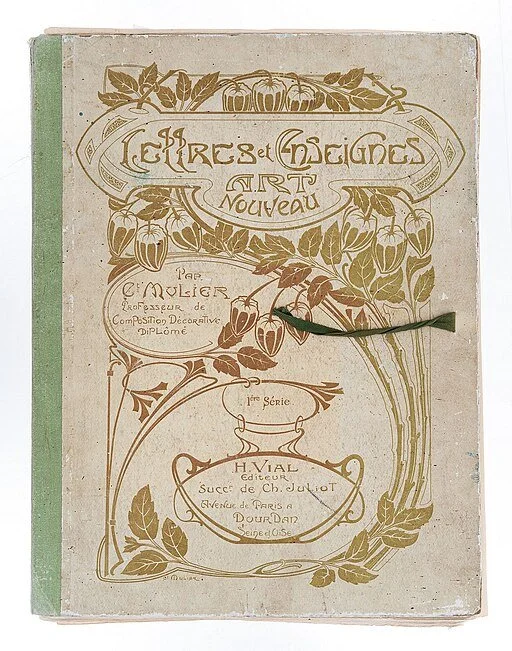Learning from Design Schools: Inspiration from Iconic Movements
Introduction
Today, I want to take you on a journey through some incredible historical art movements that have shaped the world of design. As a surface pattern designer and a fan of art history, I’ve found endless inspiration in the teachings and aesthetics of renowned design schools like the Bauhaus, Swiss Style, Arts and Crafts Movement, Art Nouveau, and the Wiener Werkstätte. Let’s dive in together and discover how these movements can enrich our own creative practices.
Stalenboek Wiener Werkstätte 1910-1925 - Dagobert Peche
The Bauhaus: Form Follows Function
First up is the iconic Bauhaus, founded in 1919 by Walter Gropius in Germany. This school was all about blending fine arts with crafts and championed the idea that “form follows function.” What does that mean for us? It’s a reminder to prioritize utility in our designs without sacrificing beauty.
Key Takeaways:
Simplicity and Functionality: Embrace the beauty of clean lines and essential forms. Stripping away the unnecessary can lead to designs that are not only modern but also resonate deeply with viewers.
Collaboration: The Bauhaus fostered collaboration across various disciplines. So, why not explore different mediums and art forms in your work? You might just stumble upon something magical.
Swiss Style: Clarity & Grids
Next, let’s discuss the Swiss Style, which emerged in the 1950s and is renowned for its clarity and simplicity. This movement emphasizes the importance of grid systems in layout design, serving as a roadmap for your creative process.
Key Takeaways:
Using Grids: A grid isn’t just a structure; it’s a vital tool for harmony and alignment. As surface pattern designers, we can harness grids to create visually appealing and balanced compositions. In my book, Treasure Found: An Art Journey, I discuss how grids help organize and align the elements in my artwork. They guide our eyes toward order and patterns, creating a sense of balance, even in the most intricate designs.
Typography Matters: The Swiss Style teaches us to treat typography as a vital visual element. Experimenting with type can add a whole new dimension to your designs, allowing you to explore various styles that complement your patterns.
Arts & Crafts Movement: Handcrafted Beauty
Now, let’s journey back to the Arts and Crafts Movement, which began in the late 19th and early 20th centuries. This movement celebrates craftsmanship and a connection to nature. It’s all about infusing artistry into everyday objects.
Key Takeaways:
Nature Inspiration: Nature is an endless source of creativity. Incorporate organic shapes and earthy colors into your patterns to evoke a sense of tranquility and harmony.
Handcrafted Aesthetics: Embrace the beauty of the handmade. Adding artisanal techniques to your designs can create unique, character-rich pieces that stand out.
Art Nouveau: Flowing Forms & Whimsy
I can’t forget about Art Nouveau, a movement that began in the late 19th century with its intricate, flowing lines and whimsical motifs. This style encourages us to let our creativity flow freely and embrace the beauty of nature.
Key Takeaways:
Fluid Forms: Don’t shy away from curvy lines and organic shapes. They can add dynamism to your patterns and invite viewers into your creative world.
Ornamental Details: Infuse your designs with intricate elements that tell a story and evoke emotions. Patterns can be narratives in themselves.
Wiener Werkstätte: A Fusion of Art & Craftsmanship
Last but definitely not least, let’s talk about the Wiener Werkstätte, which I absolutely adore. Founded in 1903 by Josef Hoffmann and Koloman Moser, this movement beautifully blends Art Nouveau and Art Deco influences, creating stunning designs that elevate everyday objects.
Notable Members:
Josef Hoffmann: Known for his geometric forms and harmonious design principles, Hoffmann really defined the essence of the movement.
Koloman Moser: Moser’s talents spanned various mediums, and his innovative patterns helped shape the Wiener Werkstätte's distinctive aesthetic.
Gustav Klimt: Though not an official member, Klimt’s ornate patterns and symbolic works have had a lasting impact on the decorative arts of the era.
Key Takeaways:
Interdisciplinary Collaboration: The Wiener Werkstätte celebrated artists from different disciplines coming together. As you create, think about how various artistic practices can intertwine in your work.
Focus on Patterns: The intricate patterns from the Wiener Werkstätte inspire me every day. I love incorporating bold graphics and rich motifs into my designs.
Embrace Historical Influences
By exploring the philosophies of design schools like the Bauhaus, Swiss Style, Arts and Crafts Movement, Art Nouveau, and Wiener Werkstätte, we can breathe new life into our creative practices. Each movement offers valuable lessons that can inspire fresh perspectives in our pattern designs.
Personal Reflection: As an illustrator and author, I find immense inspiration in these historical movements, particularly the Wiener Werkstätte. Their approach to design has deeply influenced my creative journey, which I explore further in my book, Treasure Found: An Art Journey. Let’s embrace the past to inspire our future creations.





















